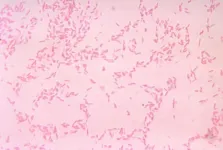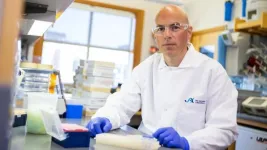(Press-News.org) By David L. Chandler
WOODS HOLE, Mass. -- Antibiotic resistance is a significant and growing medical problem worldwide. Researchers at the Marine Biological Laboratory (MBL) and collaborators have found a novel genetic arrangement that may help a common bacterium in the human gut, Bacteroides fragilis, protect itself from tetracycline, a widely used antibiotic.
While these findings will not lead directly to new ways of combating tetracycline-resistant bacteria, the researchers have discovered previously unseen genetic arrangements that confer antibiotic resistance. Such understanding might help in developing new ways to limit the spread of antibiotic resistance genes, through genetic manipulation or other means.
The findings were reported in the journal mBio by MBL scientists Joseph Vineis, Mitchell Sogin and Blair Paul, along with colleagues from MBL, Argonne National Laboratory, and the University of Chicago.
The bacteria they studied, Bacteroides fragilis, was recovered from a patient with ulcerative colitis, where it was found to be abundant during periods of inflammation. The team had a large set of samples to analyze from patients with inflammatory bowel disease that had been surgically treated to alleviate the inflammation.
These samples were studied at MBL using shotgun metagenomics, which produces sequences for all the genetic material in an entire community of microbial cells. It also facilitates cultivation of bacterial strains from the community, providing the data required to observe the activity of the tetracycline-resistance genes while growing in the presence of tetracycline. (At the time they started this work, Vineis says, “to be able to reconstruct genomes from metagenomic data was just getting started in the field. It was a novel approach, but now it’s common.”)
“When we looked at the data,” Vineis says, “there was a very strong signal” showing high numbers of copies of particular regions of the bacterial genomes. One of these regions, encompassing many genes, “was very abundant” in the sample, and later they were able to determine “that this particular high-copy region contained tetracycline resistance… So we kept digging.”
These high-copy sections of the genome contained DNA fragments that can move around in the genome or even jump into a different genome. Called transposons, these mobile genetic elements are “important ways for bacteria to develop adaptations to the environment without having to reinvent them themselves completely,” Vineis says. And in the human intestines, where vast numbers of species of gut bacteria are constantly in close proximity, “the potential for exchange is really high,” he says, and the rate increases when there is inflammation.
Such exchange of genetic material between different species is called horizontal transfer. Blair Paul, an assistant scientist at MBL, says that “we think these transposons are actually a key vehicle for horizontal gene transfer.”
In this case, the bacteria apparently sense when there is tetracycline in the environment and begin “a whole cascade” of production of a transposon containing the resistance gene, Vineis says.
The part of the transposon containing the resistance gene, they found, occurred in two different forms within the same genome: Sometimes it is in its normal linear form, and sometimes rolled into a circle. Both forms occur at once in the Bacteroides fragilis genome, but the linear form contains a unique genomic insert in the region of DNA that encodes the machinery for mobilization into other cells.
“This hasn’t been seen before, to our knowledge,” Paul says, “this particular type of transposon having a subregion amplified. And it’s occurring in bacteria that coincide with inflammation.”
The increased expression of this group of genes is potentially associated with the success of Bacteroides fragilis during inflammation, although the connection is not yet proven and requires further research. But Paul says the findings “raise new questions about the role of gene transfer in human health, but also in terms of just how these transposons are controlled and how they may be changing evolutionarily over time.”
“This finding is not going to change our understanding about the world of antibiotic resistance, but it’s a novel kind of mechanism that at least we can start looking for,” Vineis says. “There’s a lot of offense and defense happening within the microbial world that we’re not even fully aware of.”
—###—
The Marine Biological Laboratory (MBL) is dedicated to scientific discovery – exploring fundamental biology, understanding marine biodiversity and the environment, and informing the human condition through research and education. Founded in Woods Hole, Massachusetts in 1888, the MBL is a private, nonprofit institution and an affiliate of the University of Chicago.
END
Smoking changes the way genes are expressed, which later contributes to the development of lung cancer and other smoking-related illnesses. But the link between epigenetics (the study of mechanisms that impact gene expression) and smoking is not fully understood, especially in terms of differences across racial and ethnic groups.
“We know that smoking affects people differently based on their race and ethnicity, but identifying epigenetic signatures of smoking would help us better predict risk for smoking-related diseases,” said Brian Huang, PhD, an assistant professor in the department of population ...
Dr. Pieter Gunnink from the Institute of Physics at Johannes Gutenberg University Mainz (JGU) has been awarded a EUR 190,000 Marie Skłodowska-Curie Postdoctoral Fellowship by the European Commission. The grant is an individual award for Gunnink's outstanding achievements in the field of spintronics and provides financial support for his research over a period of 24 months.
Modern information processing relies heavily on the use of electrical current, the transport of which requires large amounts of energy. The field of ...
Associate Professor Ron Korstanje, Ph.D., has been named the Evnin Family Chair at The Jackson Laboratory. An expert in the genetics of kidney function and disease, Korstanje’s appointment marks a new chapter in his 20 years of service to JAX’s mission.
“Ron’s exceptional contributions to JAX have advanced research discoveries and nurtured generations of future scientists,” said President and CEO Lon Cardon, Ph.D., FMedSci. “His appointment as the Evnin Family ...
In a collaborative effort to improve the food industry, Dr. Mustafa Akbulut, professor of chemical engineering, and Dr. Luis Cisneros-Zevallos, professor of horticultural science, have developed a two-step coating solution for galvanized steel that is more hygienic and reduces the risk of corrosion.
Galvanized steel containers and surfaces are used for harvested produce because of their durability, strength and lower cost compared to stainless steel. However, bacteria residing in storage containers can cause corrosion.
The ...
DURHAM, N.C. – A perplexing problem for people with recurring urinary tract infections (UTIs) is persistent pain, even after antibiotics have successfully cleared the bacteria.
Now Duke Health researchers have identified the likely cause - an overgrowth of nerve cells in the bladder.
The finding, appearing March 1 in the journal Science Immunology, provides a potential new approach to managing symptoms of recurring UTIs that would more effectively target the problem and reduce unnecessary antibiotic usage.
“Urinary tract infections account for almost 25% of infections in women,” said senior author Soman Abraham, Ph.D., professor in the departments ...
T follicular helper cells (Tfh) are essential for strong antibody-mediated reactions of our immune system during infections and vaccinations. However, if they get out of control, this can cause diseases such as autoimmunity, allergies or cancer. Researchers from the University Hospital Bonn (UKB) and the Cluster of Excellence ImmunoSensation2 at the University of Bonn investigated the underlying mechanisms of Tfh cell development in a mouse model and thus decoded their internal networking. They hope that this will lead to new strategies for the development of highly effective vaccines and new therapies to combat various diseases. The results have ...
More than half of smokers in England wrongly believe that vaping is more harmful or as harmful as smoking, according to a new study led by UCL (University College London) researchers.
The study, published in the journal JAMA Network Open and funded by Cancer Research UK, looked at survey responses from 28,393 smokers in England between 2014 and 2023.
The research team found that public perceptions of e-cigarettes had worsened considerably over the past decade, with an overall increase in the perceived harm of e-cigarettes since 2021, coinciding with a sharp rise in vaping among young ...
WHAT:
Researchers at the National Institutes of Health have identified antibodies targeting a hard-to-spot region of the influenza virus, shedding light on the relatively unexplored “dark side” of the neuraminidase (NA) protein head. The antibodies target a region of the NA protein that is common among many influenza viruses, including H3N2 subtype viruses, and could be a new target for countermeasures. The research, led by scientists at the National Institute of Allergy and Infectious Diseases’ Vaccine Research Center, part of NIH, was published today in Immunity.
Influenza, or flu, sickens millions ...
Fred Hutchinson Cancer Center announced 12 recipients of the 2024 Harold M. Weintraub Graduate Student Award, which recognizes exceptional achievement in graduate studies in the biological sciences.
This year’s recipients come from U.S. and international research institutions with thesis topics that include brain signals related to learning and emotion, bacterial pathogens and health, AI algorithms in rare disease diagnosis and treatment, and immune cells involved in brain tumors.
“Weintraub awardees showcase how scientists are using advancements in technology to explore questions that have been out of reach,” said Jihong Bai, ...
STARKVILLE, Miss. -- Mississippi State University's Department of Computer Science and Engineering has launched a new open-access academic journal focused on advancements in artificial intelligence.
The journal AI Letters aims to fill a gap in peer-reviewed publications covering AI research. Department Head Shahram Rahimi and Assistant Research Professor Noorbakhsh Amiri Golilarz, editors-in-chief of the journal, saw the need for a publication that could quickly share new ideas and insights in AI, a hot topic ...





